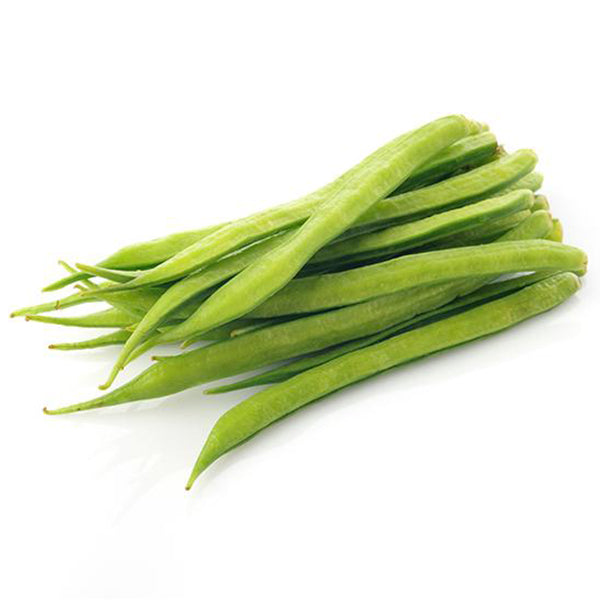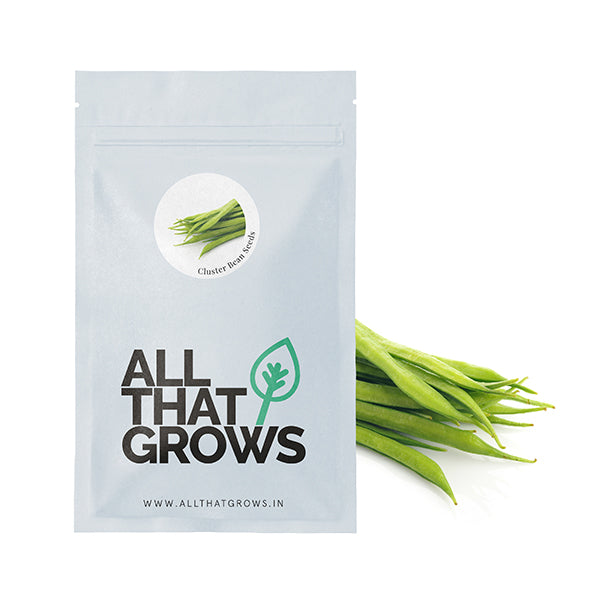



- SOWING
TIMEFebruary - March, June-July
- Sowing
DistancePlant to Plant - 4 to 6 inches, Line to Line - 18 to 24 inches
- Fruit
WeightN/A
- Fruit
ShapeN/A
- Days to
maturity60-65 days after sowing
- Details
- How to sow
- Reviews
Cluster bean or guar bean is a popular staple in many parts of South Asia and has been cultivated for centuries in India. Botanically known as Cyamopsis tetragonoloba, Cluster bean is a member of the Fabaceae bean family. Besides being a popular vegetable crop, cluster bean is also grown as a green cover crop for soil. Cluster beans are a rich source of dietary fibre, manganese, calcium, iron and potassium. Cluster bean also contains high levels of galactomannan gum making it useful as a food thickening agent, and an important element in the drilling industry to break apart rocks. Cluster bean can be used as a substitute in all green bean recipes including daals, stir-frys, curries, soups etc. As a health food, consumption of cluster beans can help in managing diabetes, heart health and bone strength.
Planting instructions
Cluster beans will grow well in well-drained loamy or sandy soil. Sow seeds at a depth of ½ inches in a sunny spot and cover with loosely packed soil. Cluster beans have a long taproot, hence it is recommended to plant it directly in the garden. Cluster beans can also be planted in a 5-6 gallon container. The seeds should start germinating in 7-8 days under ideal conditions.
Growing Requirements
pests & diseases
Leaf spotting and powdery mildew are the most common diseases that can affect the plant. In addition to this leaf miner and pod borers can also attack the plant if not checked and cared for regularly
soil
Cluster beans grow well in well-draining loamy and sandy soil with a pH ranging between 7 to 8.
spot
A sunny location that receives 5-6 hours of sunlight every day is very important for the growth of the cluster bean plant.
temperature
The ideal soil temperature for germination of seeds ranges between 30 to 35℃. Moreover, the plant will thrive in the growing temperature ranging from 30 to 40℃.
watering
Watering needs may vary depending on the season the cluster beans are sown in the garden. For instance, you may need to water once-twice every day during the summers and once every alternate day during the monsoon or autumn.
how to harvest
Cluster bean pods will get to harvest in 60 to 70 days after sowing. The bean pods can be picked by cutting or twisting with hands. Perpetual harvesting will also promote more fruit growth in the plant. It is also advisable to snip off yellowing branches and leaves for a stronger plant.

Customer Reviews
The productiveness of any seed we sell is subject to your local climatic conditions*, the sowing method you adopt, and your commitment to the planting process. We give no warranty, expressed or implied, and are in no way responsible for the produce.
Please note that all our seasonal recommendations/ sowing information is as per the local climatic conditions. *For more information on the optimum conditions required for growing seeds in your region, please contact us at, hello@allthatgrows.in or Whatsapp us at, +91 8544865077
Questions & Answers
Have a Question?
Be the first to ask a question about this.




Cluster Bean Seeds
Seed Type : Non-Hybrid, Open Pollinated and Non-GMO
SOWING TIME : February - March, June-July
PODS : Tender light green colour pods
POD LENGTH : 4-5 inches
DAYS TO MATURITY : 60-65 days after sowing
Recommended with this
Cluster bean or guar bean is a popular staple in many parts of South Asia and has been cultivated for centuries in India. Botanically known as Cyamopsis tetragonoloba, Cluster bean is a member of the Fabaceae bean family. Besides being a popular vegetable crop, cluster bean is also grown as a green cover crop for soil. Cluster beans are a rich source of dietary fibre, manganese, calcium, iron and potassium. Cluster bean also contains high levels of galactomannan gum making it useful as a food thickening agent, and an important element in the drilling industry to break apart rocks. Cluster bean can be used as a substitute in all green bean recipes including daals, stir-frys, curries, soups etc. As a health food, consumption of cluster beans can help in managing diabetes, heart health and bone strength.
Seed Type : Non-Hybrid, Open Pollinated and Non-GMO
SOWING TIME : February - March, June-July
PODS : Tender light green colour pods
POD LENGTH : 4-5 inches
DAYS TO MATURITY : 60-65 days after sowing
- SOWING
TIMEFebruary - March, June-July
- Sowing
DistancePlant to Plant - 4 to 6 inches, Line to Line - 18 to 24 inches
- Fruit
WeightN/A
- Fruit
ShapeN/A
- Days to
maturity60-65 days after sowing
Planting instructions
Cluster beans will grow well in well-drained loamy or sandy soil. Sow seeds at a depth of ½ inches in a sunny spot and cover with loosely packed soil. Cluster beans have a long taproot, hence it is recommended to plant it directly in the garden. Cluster beans can also be planted in a 5-6 gallon container. The seeds should start germinating in 7-8 days under ideal conditions.
Growing Requirements
pests & diseases
Leaf spotting and powdery mildew are the most common diseases that can affect the plant. In addition to this leaf miner and pod borers can also attack the plant if not checked and cared for regularly
soil
Cluster beans grow well in well-draining loamy and sandy soil with a pH ranging between 7 to 8.
spot
A sunny location that receives 5-6 hours of sunlight every day is very important for the growth of the cluster bean plant.
temperature
The ideal soil temperature for germination of seeds ranges between 30 to 35℃. Moreover, the plant will thrive in the growing temperature ranging from 30 to 40℃.
watering
Watering needs may vary depending on the season the cluster beans are sown in the garden. For instance, you may need to water once-twice every day during the summers and once every alternate day during the monsoon or autumn.
how to harvest
Cluster bean pods will get to harvest in 60 to 70 days after sowing. The bean pods can be picked by cutting or twisting with hands. Perpetual harvesting will also promote more fruit growth in the plant. It is also advisable to snip off yellowing branches and leaves for a stronger plant.



 Sign In
Sign In








